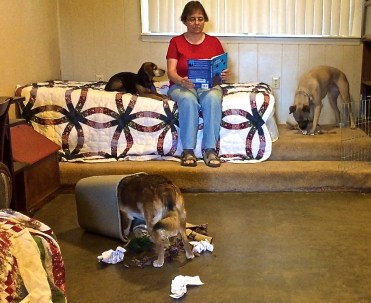Barks Blog
Six Myths about Positive Reinforcement-Based Training
Positive reinforcement-based training is subject to a lot of misunderstanding and misrepresentation. Many people genuinely don’t understand how it works, and others seem to deliberately misrepresent it. Some of these misunderstandings and misrepresentations are very “sticky.” Misunderstandings, straw men, myths–call them what you will, but they are out there and they are potent.
Here are six that are quite common. There are many more out there. For example, I didn’t even hit on “dogs trained with R+ are obese” or “R+ training only works for tricks and easy dogs” or “R+ training is bribery.” But the following six illuminate some common misunderstandings about positive reinforcement-based training.
- Positive reinforcement-based training is permissive. I believe this one is a true misunderstanding for a lot of people. Before I started studying learning theory, I certainly would have had no clue how one could use positive reinforcement as part of a training plan, for instance, to get rid of an unwanted behavior. All I could imagine was someone passing out cookies for good behavior. It seemed like a good recipe for chaos. What would one do with a cookie if the dog did something “bad”? What I didn’t know was that positive reinforcement-based trainers not only reinforce desired behaviors, but also have several humane techniques for interfering with the reinforcement for unwanted behaviors so that they don’t pay off for the animal. These include antecedent arrangement, reinforcement of alternative behaviors, and in some cases negative punishment. Positive reinforcement-based training, especially when applied to behavior problems, takes careful thought and planning. It is precise, deliberate, and the opposite of “let’s all hang out here in happy fairy rainbow land.”
 Positive reinforcement-based trainers just ignore bad behavior.The one also brings a very bad image to mind: a doting pet owner letting her pet jump on grandma, countersurf, and go through the trash. But the truth is quite different. What we actually do about unwanted behavior is to 1) prevent it from happening in the first place; 2) teach the dog something acceptable to do instead; and occasionally, 3) punish it using negative punishment. We know that ignoring reinforced behaviors doesn’t make them go away. But to make things a little more complicated, there are two situations where “ignoring” is used in training. One is when training new behaviors and/or associating a verbal cue with a new behavior. In these cases, if the dog makes an error, nothing happens. We do not treat. But in these situations we are not dealing with some habitual, harmful behavior that is getting reinforced some other way. It’s just a wrong guess in a guessing game. The other situation where ignoring might be used as a part of a training approach is when the animal’s behavior is being reinforced with attention. But even in that situation we would not use ignoring by itself.
Positive reinforcement-based trainers just ignore bad behavior.The one also brings a very bad image to mind: a doting pet owner letting her pet jump on grandma, countersurf, and go through the trash. But the truth is quite different. What we actually do about unwanted behavior is to 1) prevent it from happening in the first place; 2) teach the dog something acceptable to do instead; and occasionally, 3) punish it using negative punishment. We know that ignoring reinforced behaviors doesn’t make them go away. But to make things a little more complicated, there are two situations where “ignoring” is used in training. One is when training new behaviors and/or associating a verbal cue with a new behavior. In these cases, if the dog makes an error, nothing happens. We do not treat. But in these situations we are not dealing with some habitual, harmful behavior that is getting reinforced some other way. It’s just a wrong guess in a guessing game. The other situation where ignoring might be used as a part of a training approach is when the animal’s behavior is being reinforced with attention. But even in that situation we would not use ignoring by itself.- Positive reinforcement trainers believe that nothing unpleasant should happen in the dog’s life, ever, and they try to protect their dogs from all aversives. First, this is impossible. Mild to moderate aversive stimuli are around us at all times, and we–and our animals–perform loads of behaviors to avoid or lessen them. Perhaps the dog is too hot. That’s aversive. Perhaps there is a fly buzzing around her head. That’s aversive. Perhaps the dog has to get a shot at the vet. That’s aversive! The truth is that we avoid training with aversives, even with mild ones. As I’ve written elsewhere, if a thunder-phobic dog escapes into the house when it storms, this is called natural or automatic negative reinforcement. The dog is reinforced for running into the house by gaining distance from the thunder noise. The thunder is an unavoidable aversive in life. (I help my dogs deal with it in other ways besides mere escape.) But I would never put a loud noise into a training session and use a dog’s fear of it to get a certain behavior out of her. And as for major aversives (thinking vet visit again)–we do prepare the dog for them as best we can to make them less so. That’s the opposite ofusing their aversive qualities.
- Because of #3, positive reinforcement-based trainers will do things likelet their dog run out in traffic so as to avoid jerking on his collar, or avoid any medical procedure that might “hurt.” This one is almost always a straw man. I’m pretty sure the people saying it and acting like they believe it really don’t think we would stand by in an emergency and watch our dogs get hurt. In an emergency we will body block or grab or tackle or apply leash pressure to a dog who is about to do something dangerous, just like any other normal human being who cares about his or her dog. Yes, this is using an aversive. But it is not part of a teaching scenario. Different behaviors are expected and needed in difficult situations. For example, a friend might ask me to use a needle to remove a sliver that she can’t reach. I would do this if asked, even if it might mean hurting her. But because I am willing to do that, it does not follow that I am fine with training her a new job skill by poking her with a needle every time she makes an error.
- Positive reinforcement-based trainers use punishment but just don’t know it (or just don’t admit it). This is silly. We are generally the ones who are trying our best to leave mythology behind and learn the science behind good training. But again, the claim can come from someone who just doesn’t understand what it is we are doing; someone who figures there just has to be punishment in there somewhere! Sometimes there is. And those of us who use negative punishment know when we are using it! But a common variant of this claim is, “When you train, you don’t always give the dog the treat. You are withholding the reward and that’s punishment, har har har.” Actually it is not. As long as there is no consequence to the dog’s wrong guess it is not punishment. It is extinction at work. Extinction by itself is no picnic for the dog either, but in general we don’t use it by itself. Usually another behavior or multiple other behaviors are being reinforced, and we help the animal make the transition to performing one of those instead. We also know and freely admit that certain tools fall easily into aversive use. It’s no news that a plain old collar can be used to hurt a dog. That’s why when we start using any gear on a dog, we use counterconditioning to help the dog build pleasant associations, and we teach the dog behaviors so as to minimize the chance of discomfort. This is the opposite of using the aversive properties of a piece of gear.
- Positive reinforcement-based training is just as stressful on dogs as balanced or aversive-based training. Training with positive reinforcement can surely be stressful. But as I’ve written elsewhere, the stressors generally have to do with lack of skill (errors by the trainer), or an added aversive situation that wasn’t planned. It is not sensible to argue that a method that consists of giving the dog food or playing with her when she performs a desirable behavior is as aversive as a method that depends on applying discomfort, pain, or intimidation.
The Commonalities
Every one of these points is focused on punishment or aversive stimuli. Clearly that is a sticking point in people’s understanding of positive reinforcement-based training. The claims also fit neatly into two categories. The first four misrepresent positive reinforcement-based training. They paint it in a ridiculous light and imply it is impossible or ineffective. The last two blur the lines between positive reinforcement-based training and training that involves deliberate use of aversives.
In rhetorical terms, the first four are straw man arguments, and the latter two use the tu quoque fallacy in addition to the continuum fallacy. (Follow the links for definitions and examples of the individual terms.)
But as irritating as it is to read and hear these over and over, I try to keep in mind that they can be made from ignorance rather than malice. This is described nicely in the straw manlink. Every one of us grew up in a culture that instructs us to use aversives to attempt to change behavior. The “cultural fog” around learning and behavior that Dr. Susan Friedman refers to makes us leery of reinforcement, and can cause us to equate it with mere indulgence or even moral corruption.
I am sure that many of the people who make these arguments are completely unfamiliar with the planning and precision that necessarily go into positive reinforcement training plans. I know I was. I got over it by listening to you folks out there who patiently explained the processes involved in positive reinforcement-based training. I hope you keep describing to the world what you do!
Related Page
Misconceptions about R+ Training (a compendium)
© Eileen Anderson 2015 eileenanddogs.com

